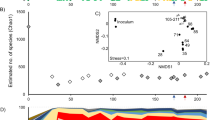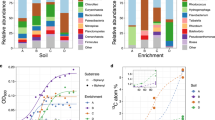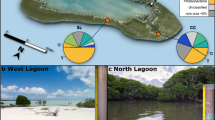Abstract
Global groundwater resources are constantly challenged by a multitude of contaminants such as aromatic hydrocarbons. Especially in anaerobic habitats, a large diversity of unrecognized microbial populations may be responsible for their degradation. Still, our present understanding of the respective microbiota and their ecophysiology is almost exclusively based on a small number of cultured organisms, mostly within the Proteobacteria. Here, by DNA-based stable isotope probing (SIP), we directly identified the most active sulfate-reducing toluene degraders in a diverse sedimentary microbial community originating from a tar-oil-contaminated aquifer at a former coal gasification plant. On incubation of fresh sediments with 13C7-toluene, the production of both sulfide and 13CO2 was clearly coupled to the 13C-labeling of DNA of microbes related to Desulfosporosinus spp. within the Peptococcaceae (Clostridia). The screening of labeled DNA fractions also suggested a novel benzylsuccinate synthase alpha-subunit (bssA) sequence type previously only detected in the environment to be tentatively affiliated with these degraders. However, carbon flow from the contaminant into degrader DNA was only ∼50%, pointing toward high ratios of heterotrophic CO2-fixation during assimilation of acetyl-CoA originating from the contaminant by these degraders. These findings demonstrate that the importance of non-proteobacterial populations in anaerobic aromatics degradation, as well as their specific ecophysiology in the subsurface may still be largely ungrasped.
Similar content being viewed by others
Log in or create a free account to read this content
Gain free access to this article, as well as selected content from this journal and more on nature.com
or
Accession codes
References
Abu Laban N, Selesi D, Jobelius C, Meckenstock RU . (2009). Anaerobic benzene degradation by Gram-positive sulfate-reducing bacteria. FEMS Microbiol Ecol 68: 300–311.
Andreoni V, Gianfreda L . (2007). Bioremediation and monitoring of aromatic-polluted habitats. Appl Microbiol Biotechnol 76: 287–308.
Anneser B, Einsiedl F, Meckenstock RU, Richters L, Wisotzky F, Griebler C . (2008). High-resolution monitoring of biogeochemical gradients in a tar oil-contaminated aquifer. Appl Geochem 23: 1715–1730.
Bockelmann A, Ptak T, Teutsch G . (2001). An analytical quantification of mass fluxes and natural attenuation rate constants at a former gasworks site. J Contam Hydrol 53: 429–453.
Boll M, Fuchs G, Heider J . (2002). Anaerobic oxidation of aromatic compounds and hydrocarbons. Curr Opin Chem Biol 6: 604–611.
Bombach P, Chatzinotas A, Neu TR, Kästner M, Lueders T, Vogt C . (2010). Enrichment and characterization of a sulfate-reducing toluene-degrading microbial consortium by combining in situ microcosms and stable isotope probing techniques. FEMS Microbiol Ecol 71: 237–246.
Bruns A, Cypionka H, Overmann J . (2002). Cyclic AMP and acyl homoserine lactones increase the cultivation efficiency of heterotrophic bacteria from the central Baltic Sea. Appl Environ Microbiol 68: 3978–3987.
Buckley DH, Huangyutitham V, Hsu S-F, Nelson TA . (2007). Stable isotope probing with 15N achieved by disentangling the effects of genome G+C content and isotope enrichment on DNA density. Appl Environ Microbiol 73: 3189–3195.
Callaghan AV, Wawrik B, Ní Chadhain SM, Young LY, Zylstra GJ . (2008). Anaerobic alkane-degrading strain AK-01 contains two alkylsuccinate synthase genes. Biochem Biophys Res Commun 366: 142–148.
Chivian D, Brodie EL, Alm EJ, Culley DE, Dehal PS, DeSantis TZ et al. (2008). Environmental genomics reveals a single-species ecosystem deep within earth. Science 322: 275–278.
Cline JD . (1969). Spectrophotometric determination of hydrogen sulfide in natural waters. Limnol Oceanogr 14: 454–458.
Franzmann PD, Robertson WJ, Zappia LR, Davis GB . (2002). The role of microbial populations in the containment of aromatic hydrocarbons in the subsurface. Biodegradation 13: 65–78.
Gallagher E, McGuinness L, Phelps C, Young LY, Kerkhof LJ . (2005). 13C-carrier DNA shortens the incubation time needed to detect benzoate-utilizing denitrifying bacteria by stable-isotope probing. Appl Environ Microbiol 71: 5192–5196.
Galvao TC, Mohn WW, de Lorenzo V . (2005). Exploring the microbial biodegradation and biotransformation gene pool. Trends Biotechnol 23: 497–506.
Griebler C, Safinowski M, Vieth A, Richnow HH, Meckenstock RU . (2004). Combined application of stable carbon isotope analysis and specific metabolites determination for assessing in situ degradation of aromatic hydrocarbons in a tar oil-contaminated aquifer. Environ Sci Technol 38: 617–631.
Grundmann O, Behrends A, Rabus R, Amann J, Halder T, Heider J et al. (2008). Genes encoding the candidate enzyme for anaerobic activation of n-alkanes in the denitrifying bacterium, strain HxN1. Environ Microbiol 10: 376–385.
Heider J, Fuchs G . (1997). Anaerobic metabolism of aromatic compounds. Eur J Biochem 243: 577–596.
Herfort M, Ptak T, Hümmer O, Teutsch G, Dahmke A . (1998). Testfeld Süd: Einrichtung der Testfeldinfrastruktur und Erkundung hydraulisch-hydrogeochemischer Parameter des Grundwasserleiters. Grundwasser 4: 159–166.
Herrmann S, Kleinsteuber S, Chatzinotas A, Kuppardt S, Lueders T, Richnow H-H et al. (2010). Functional characterization of an anaerobic benzene-degrading enrichment culture by DNA stable isotope probing. Environ Microbiol 12: 401–411.
Jeon CO, Park W, Padmanabhan P, DeRito C, Snape JR, Madsen EL . (2003). Discovery of a bacterium, with distinctive dioxygenase, that is responsible for in situ biodegradation in contaminated sediment. Proc Natl Acad Sci USA 100: 13591–13596.
Kasai Y, Takahata Y, Manefield M, Watanabe K . (2006). RNA-based stable isotope probing and isolation of anaerobic benzene-degrading bacteria from gasoline-contaminated groundwater. Appl Environ Microbiol 72: 3586–3592.
Kittelmann S, Friedrich MW . (2008). Identification of novel perchloroethene-respiring microorganisms in anoxic river sediment by RNA-based stable isotope probing. Environ Microbiol 10: 31–46.
Kosaka T, Uchiyama T, Ishii S-I, Enoki M, Imachi H, Kamagata Y et al. (2006). Reconstruction and regulation of the central catabolic pathway in the thermophilic propionate-oxidizing syntroph pelotomaculum thermopropionicum. J Bacteriol 188: 202–210.
Kunapuli U, Lueders T, Meckenstock RU . (2007). The use of stable isotope probing to identify key iron-reducing microorganisms involved in anaerobic benzene degradation. ISME J 1: 643–653.
Leigh MB, Pellizari VH, Uhlik O, Sutka R, Rodrigues J, Ostrom NE et al. (2007). Biphenyl-utilizing bacteria and their functional genes in a pine root zone contaminated with polychlorinated biphenyls (PCBs). ISME J 1: 134–148.
Liou JSC, DeRito CM, Madsen EL . (2008). Field-based and laboratory stable isotope probing surveys of the identities of both aerobic and anaerobic benzene-metabolizing microorganisms in freshwater sediment. Environ Microbiol 10: 1964–1977.
Liu A, Garcia-Dominguez E, Rhine ED, Young LY . (2004). A novel arsenate respiring isolate that can utilize aromatic substrates. FEMS Microbiol Ecol 48: 323–332.
Lueders T . (2009). Stable isotope probing of hydrocarbon-degraders. In: Timmis KN (ed). Handbook of Hydrocarbon and Lipid Microbiology. Springer: Berlin, Heidelberg, pp 4011–4026.
Lueders T, Kindler R, Miltner A, Friedrich MW, Kaestner M . (2006). Identification of bacterial micropredators distinctively active in a soil microbial food web. Appl Environ Microbiol 72: 5342–5348.
Lueders T, Manefield M, Friedrich MW . (2004). Enhanced sensitivity of DNA- and rRNA-based stable isotope probing by fractionation and quantitative analysis of isopycnic centrifugation gradients. Environ Microbiol 6: 73–78.
Manefield M, Griffiths R, McNamara NP, Sleep D, Ostle N, Whiteley A . (2007). Insights into the fate of a 13C labelled phenol pulse for stable isotope probing (SIP) experiments. J Microbiol Meth 69: 340–344.
Meckenstock RU . (1999). Fermentative toluene degradation in anaerobic defined syntrophic cocultures. FEMS Microbiol Lett 177: 67–73.
Morasch B, Annweiler E, Warthmann R, Meckenstock RU . (2001). The use of a solid adsorber resin for enrichment of bacteria with toxic substrates and to identify metabolites: degradation of naphthalene, o-, and m-xylene by sulfate-reducing bacteria. J Microbiol Meth 44: 183–191.
Morasch B, Schink B, Tebbe CC, Meckenstock RU . (2004). Degradation of o-xylene and m-xylene by a novel sulfate-reducer belonging to the genus Desulfotomaculum. Arch Microbiol 181: 407–417.
Musat F, Galushko A, Jacob J, Widdel F, Kube M, Reinhardt R et al. (2009). Anaerobic degradation of naphthalene and 2-methylnaphthalene by strains of marine sulfate-reducing bacteria. Environ Microbiol 11: 209–219.
Muyzer G, Teske A, Wirsen CO, Jannasch HW . (1995). Phylogenetic relationships of Thiomicrospira species and their identification in deep-sea hydrothermal vent samples by denaturing gradient gel electrophoresis of 16S rDNA fragments. Arch Microbiol 164: 165–172.
Neufeld J, Dumont M, Vohra J, Murrell J . (2007). Methodological considerations for the use of stable isotope probing in microbial ecology. Microb Ecol 53: 435–442.
Nichols D . (2007). Cultivation gives context to the microbial ecologist. FEMS Microbiol Ecol 60: 351–357.
Oka AR, Phelps CD, McGuinness LM, Mumford A, Young LY, Kerkhof LJ . (2008). Identification of critical members in a sulfidogenic benzene-degrading consortium by DNA stable isotope probing. Appl Environ Microbiol 74: 6476–6480.
Pei A, Nossa CW, Chokshi P, Blaser MJ, Yang L, Rosmarin DM et al. (2009). Diversity of 23S rRNA genes within individual prokaryotic genomes. PLoS ONE 4: e5437.
Rabus R . (2005). Functional genomics of an anaerobic aromatic-degrading denitrifying bacterium, strain EbN1. Appl Microbiol Biotechnol 68: 580–587.
Rappé MS, Giovannoni SJ . (2003). The uncultured microbial majority. Annu Rev Microbiol 57: 369–394.
Robertson WJ, Bowman JP, Franzmann PD, Mee BJ . (2001). Desulfosporosinus meridiei sp nov., a spore-forming sulfate-reducing bacterium isolated from gasolene-contaminated groundwater. Int J Syst Evol Microbiol 51: 133–140.
Spring S, Rosenzweig F . (2006). The genera Desulfitobacterium and Desulfosporosinus: taxonomy. The Prokaryotes. Springer: Berlin, Heidelberg, pp 771–786.
Thullner M, Regnier P, Van Cappellen P . (2007). Modeling microbially induced carbon degradation in redox-stratified subsurface environments: concepts and open questions. Geomicrobiol J 24: 139–155.
Weisburg WG, Barns SM, Pelletier DA, Lane DJ . (1991). 16S ribosomal DNA amplification for phylogenetic study. J Bacteriol 173: 697–703.
Widdel F . (2006). The genus Desulfotomaculum. The Prokaryotes. Springer: Berlin, Heidelberg, pp 787–794.
Widdel F, Bak F . (1992). Gram negative mesophilic sulfate reducing bacteria. In: Balows A, Trüper HG, Dworkin M, Harder W and Schleifer K-H (eds). The Prokaryotes, 2nd edn Springer: New York, NY, pp 3352–3378.
Widdel F, Boetius A, Rabus R . (2006). Anaerobic biodegradation of hydrocarbons including methane. The Prokaryotes pp 1028–1049.
Winderl C, Anneser B, Griebler C, Meckenstock RU, Lueders T . (2008). Depth-resolved quantification of anaerobic toluene degraders and aquifer microbial community patterns in distinct redox zones of a tar oil contaminant plume. Appl Environ Microbiol 74: 792–801.
Winderl C, Schaefer S, Lueders T . (2007). Detection of anaerobic toluene and hydrocarbon degraders in contaminated aquifers using benzylsuccinate synthase (bssA) genes as a functional marker. Environ Microbiol 9: 1035–1046.
Zamfirescu D, Grathwohl P . (2001). Occurrence and attenuation of specific organic compounds in the groundwater plume at a former gasworks site. J Contam Hydrol 53: 407–427.
Acknowledgements
This work was supported by grants from the Deutsche Forschungsgemeinschaft (DFG) within the Research Unit ‘Analysis and Modeling of Diffusion/Dispersion-limited Reactions in Porous Media’ (FOR 525), as well as the Priority Programme ‘Anaerobic Transformation of Hydrocarbons’ (SPP 1319). The authors thank T Wendel and D Steidle (University of Tübingen) for the help with site access, G Teichmann (IGÖ, Neuherberg) for help with GC-MS and U.Kunapuli (IGÖ) for help with medium preparation.
Author information
Authors and Affiliations
Corresponding author
Rights and permissions
About this article
Cite this article
Winderl, C., Penning, H., Netzer, F. et al. DNA-SIP identifies sulfate-reducing Clostridia as important toluene degraders in tar-oil-contaminated aquifer sediment. ISME J 4, 1314–1325 (2010). https://doi.org/10.1038/ismej.2010.54
Received:
Revised:
Accepted:
Published:
Issue date:
DOI: https://doi.org/10.1038/ismej.2010.54
Keywords
This article is cited by
-
Rainfall as a trigger of ecological cascade effects in an Australian groundwater ecosystem
Scientific Reports (2021)
-
Stable Isotope Probing Implicates Pseudomonas as the Methanogenic Toluene Degrader in Gasoline-Contaminated Soil
Water, Air, & Soil Pollution (2021)
-
Identity and hydrocarbon degradation activity of enriched microorganisms from natural oil and asphalt seeps in the Kurdistan Region of Iraq (KRI)
Biodegradation (2021)
-
Methanogenic degradation of branched alkanes in enrichment cultures of production water from a high-temperature petroleum reservoir
Applied Microbiology and Biotechnology (2019)
-
Enhanced degradation of pyrene and phenanthrene in sediments through synergistic interactions between microbial fuel cells and submerged macrophyte Vallisneria spiralis
Journal of Soils and Sediments (2019)



